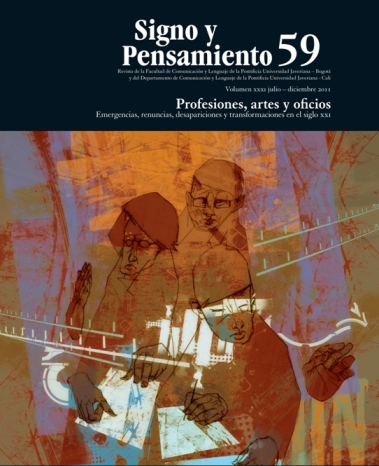Abstract
Advertising, as a marketing tool, has used the word persuasion to define its own importance, highlighting it as a key factor to determinate a purchase choice. Persuasion has served, also, to sentence advertising as manipulative tool of consumerism and creating needs, accusations that have discredited its communicative function. Thus, due to the search of marketing to establish valuable relationships with consumers, and to the new modes of business-society relationship, the essence to set this discipline must start by defining that its goal is not to persuade a consumer to choose one product over another, but to make connections between brands and their consumers through dialogue relations.
Arendt, H. (1993), La condición humana, Barcelona, Paidós. Aristóteles (1964), Retórica, Madrid, Aguilar.
Bassat, L. (1994), Libro rojo de la publicidad, Barcelona, Folio.
Benveniste, É. (1973), Problemas de lingüística general, traducción Juan Almela, México, Siglo XXI Editores.
Cadavid Gómez, H. D. (2006, febrero-abril), “Fidelización de clientes. Un concepto para pensar”, Tiempo de Mercadeo, núm. 8, pp. 23-25.
Camps, V. (1998), Ética, comunicación y política, Medellín, Universidad Pontificia Bolivariana.
Celis, C. (2010, julio-diciembre), “El oxímoron publicitario”, Pléyade, año III, núm. 6, pp. 87-97. “Colombia creció un 44,14% en conexiones de internet de banda ancha durante 2010” (2011) [en línea], disponible en http://www. revistapym.com.co/destacados/colombia-crecio-44-14-conexiones-internet-banda-anchadurante-2010, recuperado: 25 de abril de 2011.
Constantino, J. (2011), “Las marcas precisan abrir el diálogo con el consumidor para que participe” [en línea], disponible en http://www. adlatina.com/notas/noticia.php?id_noticia=39970, recuperado: 15 de febrero de 2011.
Cooper, A. (comp.) (2006), “Planning: cómo hacer el planeamiento estratégico de las comunicaciones”, Buenos Aires, Thomson. “Crece el uso de Internet desde los dispositivos móviles” (2011), disponible en http://www. adlatina.com/notas/noticia.php?id_noticia=40571, recuperado: 23 abril de 2011.
Eco, U. (1975), Apocalípticos e integrados ante la cultura de masas, traducción de Andrés Boglar, Barcelona, Lumen.
Escobedo, J. F. (2002, noviembre-diciembre), “Ciudadanos y consumidores”, Revista Mexicana de Comunicación, vol. 15, núm. 78, pp. 13, 14.
García Canclini, N. (1995), Consumidores y ciudadanos. Conflictos multiculturales de la globalización, México, Grijalbo.
Isaza, J. L. (2007, julio), “La era del top of hand”, Publicidad & Mercadeo, núm. 317, p. 9.
Luna, A. R. (2009), “De una sociedad conectada a un marketing conectado”, Tiempo de Mercadeo, núm. 19, pp. 8, 9.
Martini, S. (2000), Periodismo, noticia y noticiabilidad, Bogotá, Norma. Mattelart, A. y Mattelart, M. (1987), Pensar sobre los medios. Comunicación y crítica social, Madrid, Fundesco.
Peralba Fortuny, R. (2008, febrero-abril), “Ingeniería de marcas: el arte de calcular, diseñar, construir, mantener y restaurar marcas”, Tiempo de Mercadeo, núm. 16, pp. 27-32.
Publicidad & Mercadeo (2007, mayo), “La mano que mueve el lápiz”, Publicidad & Mercadeo, núm. 315, pp. 13-15. “La publicidad en internet supera en ingresos a la prensa escrita en Estados Unidos” (2011) [en línea], disponible en http://www.lavoz.com. ar/noticias/tecnologia/publicidad-internetsupera-ingresos-prensa-escrita-estados-unidos, recuperado: 25 de abril.
Ries, A. y Ries, L. (2003), La caída de la publicidad y el auge de las relaciones públicas, traducción de Raúl González del Río, Barcelona, Urano.
Ries, A. y Trout, J. (2002), Las veintidós (22) leyes inmutables del marketing: viólelas bajo su propio riesgo, México, McGraw-Hill.
Solano Franco, V. (2010), Comunicación [conferencia], Medellín, Universidad de Antioquia.
“Top of mind” (2011) [en línea], disponible en http://www.dinero.com/edicion-impresa/ caratula/top-of-mind_86688.aspx, recuperado: 3 de mayo.
Vásquez, H. (2007), “Juegos de seducción”, Publicidad & Mercadeo, núm. 313, p. 2.
Veliz Montero, F. (2007, diciembre), “Comunicación, organización y narrativas: construyendo desde la seducción”, Chasqui, núm. 100, pp. 22-27.
Vivas López, M. H. (2007), “Comunicación pública y formación del espacio público político”, Folios, Programa de Periodismo, Facultad de Comunicaciones, Universidad de Antioquia, núms. 12-13, pp. 8-16.
Zacipa Infante, I. (2002), Juventud, la subjetividad de la marca, Bogotá, Fundación Universidad Central, Facultad de Publicidad.
This journal is registered under a Creative Commons Attribution 4.0 International Public License. Thus, this work may be reproduced, distributed, and publicly shared in digital format, as long as the names of the authors and Pontificia Universidad Javeriana are acknowledged. Others are allowed to quote, adapt, transform, auto-archive, republish, and create based on this material, for any purpose (even commercial ones), provided the authorship is duly acknowledged, a link to the original work is provided, and it is specified if changes have been made. Pontificia Universidad Javeriana does not hold the rights of published works and the authors are solely responsible for the contents of their works; they keep the moral, intellectual, privacy, and publicity rights.
Approving the intervention of the work (review, copy-editing, translation, layout) and the following outreach, are granted through an use license and not through an assignment of rights. This means the journal and Pontificia Universidad Javeriana cannot be held responsible for any ethical malpractice by the authors. As a consequence of the protection granted by the use license, the journal is not required to publish recantations or modify information already published, unless the errata stems from the editorial management process. Publishing contents in this journal does not generate royalties for contributors.


